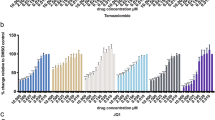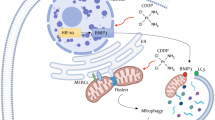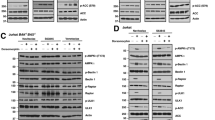Abstract
We recently identified activation of phosphatidylinositol 3′-kinase (PI3K)/Akt as a novel predictor of poor outcome in neuroblastoma. Here, we investigated the effect of small-molecule PI3K inhibitors on chemosensitivity. We provide first evidence that PI3K inhibitors, for example PI103, synergize with various chemotherapeutics (Doxorubicin, Etoposide, Topotecan, Cisplatin, Vincristine and Taxol) to trigger apoptosis in neuroblastoma cells (combination index: high synergy). Mechanistic studies reveal that PI103 cooperates with Doxorubicin to reduce Mcl-1 expression and BimEL phosphorylation and to upregulate Noxa and BimEL levels. This shifted ratio of pro- and antiapoptotic Bcl-2 proteins results in increased Bax/Bak conformational change, loss of mitochondrial membrane potential, cytochrome c release, caspase activation and caspase-dependent apoptosis. Although Mcl-1 knockdown enhances Doxorubicin- and PI103-induced apoptosis, silencing of Noxa, Bax/Bak or p53 reduces apoptosis, underscoring the functional relevance of the Doxorubicin- and PI103-mediated modulation of these proteins for chemosensitization. Bcl-2 overexpression inhibits Bax activation, mitochondrial perturbations, cleavage of caspases and Bid, and apoptosis, confirming the central role of the mitochondrial pathway for chemosensitization. Interestingly, the broad-range caspase inhibitor zVAD.fmk does not interfere with Bax activation or mitochondrial outer membrane permeabilization, whereas it blocks caspase activation and apoptosis, thus placing mitochondrial events upstream of caspase activation. Importantly, PI103 and Doxorubicin cooperate to induce apoptosis and to suppress tumor growth in patients’ derived primary neuroblastoma cells and in an in vivo neuroblastoma model, underlining the clinical relevance of the results. Thus, targeting PI3K presents a novel and promising strategy to sensitize neuroblastoma cells for chemotherapy-induced apoptosis, which has important implications for the development of targeted therapies for neuroblastoma.
This is a preview of subscription content, access via your institution
Access options
Subscribe to this journal
Receive 50 print issues and online access
$259.00 per year
only $5.18 per issue
Buy this article
- Purchase on SpringerLink
- Instant access to full article PDF
Prices may be subject to local taxes which are calculated during checkout






Similar content being viewed by others
References
Adams JM, Cory S . (2007). The Bcl-2 apoptotic switch in cancer development and therapy. Oncogene 26: 1324–1337.
Alves NL, Derks IA, Berk E, Spijker R, van Lier RA, Eldering E . (2006). The Noxa/Mcl-1 axis regulates susceptibility to apoptosis under glucose limitation in dividing T cells. Immunity 24: 703–716.
Ammann JU, Haag C, Kasperczyk H, Debatin KM, Fulda S . (2009). Sensitization of neuroblastoma cells for TRAIL-induced apoptosis by NF-kappaB inhibition. Int J Cancer 124: 1301–1311.
Brummelkamp TR, Bernards R, Agami R . (2002). A system for stable expression of short interfering RNAs in mammalian cells. Science 296: 550–553.
Chen Y, Takita J, Choi YL, Kato M, Ohira M, Sanada M et al. (2008). Oncogenic mutations of ALK kinase in neuroblastoma. Nature 455: 971–974.
Chiarini F, Fala F, Tazzari PL, Ricci F, Astolfi A, Pession A et al. (2009). Dual inhibition of class IA phosphatidylinositol 3-kinase and mammalian target of rapamycin as a new therapeutic option for T-cell acute lymphoblastic leukemia. Cancer Res 69: 3520–3528.
Chipuk JE, Kuwana T, Bouchier-Hayes L, Droin NM, Newmeyer DD, Schuler M et al. (2004). Direct activation of Bax by p53 mediates mitochondrial membrane permeabilization and apoptosis. Science 303: 1010–1014.
Dijkers PF, Medema RH, Lammers JW, Koenderman L, Coffer PJ . (2000). Expression of the pro-apoptotic Bcl-2 family member Bim is regulated by the forkhead transcription factor FKHR-L1. Curr Biol 10: 1201–1204.
Engelman JA . (2009). Targeting PI3K signalling in cancer: opportunities, challenges and limitations. Nat Rev Cancer 9: 550–562.
Fakler M, Loeder S, Vogler M, Schneider K, Jeremias I, Debatin KM et al. (2009). Small molecule XIAP inhibitors cooperate with TRAIL to induce apoptosis in childhood acute leukemia cells and overcome Bcl-2-mediated resistance. Blood 113: 1710–1722.
Fei P, Bernhard EJ, El-Deiry WS . (2002). Tissue-specific induction of p53 targets in vivo. Cancer Res 62: 7316–7327.
Flinterman M, Guelen L, Ezzati-Nik S, Killick R, Melino G, Tominaga K et al. (2005). E1A activates transcription of p73 and Noxa to induce apoptosis. J Biol Chem 280: 5945–5959.
Fulda S . (2009). The PI3K/Akt/mTOR pathway as therapeutic target in neuroblastoma. Curr Cancer Drug Targets 9: 729–737.
Fulda S, Debatin KM . (2006). Extrinsic versus intrinsic apoptosis pathways in anticancer chemotherapy. Oncogene 25: 4798–4811.
Fulda S, Sieverts H, Friesen C, Herr I, Debatin KM . (1997). The CD95 (APO-1/Fas) system mediates drug-induced apoptosis in neuroblastoma cells. Cancer Res 57: 3823–3829.
Gardai SJ, Hildeman DA, Frankel SK, Whitlock BB, Frasch SC, Borregaard N et al. (2004). Phosphorylation of Bax Ser184 by Akt regulates its activity and apoptosis in neutrophils. J Biol Chem 279: 21085–21095.
Guillard S, Clarke PA, Te Poele R, Mohri Z, Bjerke L, Valenti M et al. (2009). Molecular pharmacology of phosphatidylinositol 3-kinase inhibition in human glioma. Cell Cycle 8: 443–453.
Hacker S, Dittrich A, Mohr A, Schweitzer T, Rutkowski S, Krauss J et al. (2009). Histone deacetylase inhibitors cooperate with IFN-gamma to restore caspase-8 expression and overcome TRAIL resistance in cancers with silencing of caspase-8. Oncogene 28: 3097–3110.
Hershko T, Ginsberg D . (2004). Up-regulation of Bcl-2 homology 3 (BH3)-only proteins by E2F1 mediates apoptosis. J Biol Chem 279: 8627–8634.
Jaboin J, Kim CJ, Kaplan DR, Thiele CJ . (2002). Brain-derived neurotrophic factor activation of TrkB protects neuroblastoma cells from chemotherapy-induced apoptosis via phosphatidylinositol 3′-kinase pathway. Cancer Res 62: 6756–6763.
Kuo ML, Chuang SE, Lin MT, Yang SY . (2001). The involvement of PI 3-K/Akt-dependent up-regulation of Mcl-1 in the prevention of apoptosis of Hep3B cells by interleukin-6. Oncogene 20: 677–685.
Leber B, Lin J, Andrews DW . (2007). Embedded together: the life and death consequences of interaction of the Bcl-2 family with membranes. Apoptosis 12: 897–911.
Leu JI, Dumont P, Hafey M, Murphy ME, George DL . (2004). Mitochondrial p53 activates Bak and causes disruption of a Bak-Mcl1 complex. Nat Cell Biol 6: 443–450.
Liu P, Cheng H, Roberts TM, Zhao JJ . (2009). Targeting the phosphoinositide 3-kinase pathway in cancer. Nat Rev Drug Discov 8: 627–644.
Maris JM, Hogarty MD, Bagatell R, Cohn SL . (2007). Neuroblastoma. Lancet 369: 2106–2120.
Maurer U, Charvet C, Wagman AS, Dejardin E, Green DR . (2006). Glycogen synthase kinase-3 regulates mitochondrial outer membrane permeabilization and apoptosis by destabilization of MCL-1. Mol Cell 21: 749–760.
Niedermeier M, Hennessy BT, Knight ZA, Henneberg M, Hu J, Kurtova AV et al. (2009). Isoform-selective phosphoinositide 3′-kinase inhibitors inhibit CXCR4 signaling and overcome stromal cell-mediated drug resistance in chronic lymphocytic leukemia: a novel therapeutic approach. Blood 113: 5549–5557.
Obexer P, Geiger K, Ambros PF, Meister B, Ausserlechner MJ . (2007). FKHRL1-mediated expression of Noxa and Bim induces apoptosis via the mitochondria in neuroblastoma cells. Cell Death Differ 14: 534–547.
Opel D, Poremba C, Simon T, Debatin KM, Fulda S . (2007). Activation of Akt predicts poor outcome in neuroblastoma. Cancer Res 67: 735–745.
Qi XJ, Wildey GM, Howe PH . (2006). Evidence that Ser87 of BimEL is phosphorylated by Akt and regulates BimEL apoptotic function. J Biol Chem 281: 813–823.
Shaw RJ, Cantley LC . (2006). Ras, PI(3)K and mTOR signalling controls tumour cell growth. Nature 441: 424–430.
Stupack DG, Teitz T, Potter MD, Mikolon D, Houghton PJ, Kidd VJ et al. (2006). Potentiation of neuroblastoma metastasis by loss of caspase-8. Nature 439: 95–99.
Vogler M, Durr K, Jovanovic M, Debatin KM, Fulda S . (2007). Regulation of TRAIL-induced apoptosis by XIAP in pancreatic carcinoma cells. Oncogene 26: 248–257.
Vogler M, Walczak H, Stadel D, Haas TL, Genze F, Jovanovic M et al. (2008). Targeting XIAP bypasses Bcl-2-mediated resistance to TRAIL and cooperates with TRAIL to suppress pancreatic cancer growth in vitro and in vivo. Cancer Res 68: 7956–7965.
Vogler M, Walczak H, Stadel D, Haas TL, Genze F, Jovanovic M et al. (2009). Small molecule XIAP inhibitors enhance TRAIL-induced apoptosis and antitumor activity in preclinical models of pancreatic carcinoma. Cancer Res 69: 2425–2434.
Warr MR, Shore GC . (2008). Unique biology of Mcl-1: therapeutic opportunities in cancer. Curr Mol Med 8: 138–147.
Westhoff MA, Kandenwein JA, Karl S, Vellanki SH, Braun V, Eramo A et al. (2009). The pyridinylfuranopyrimidine inhibitor, PI-103, chemosensitizes glioblastoma cells for apoptosis by inhibiting DNA repair. Oncogene 28: 3586–3596.
Willis SN, Chen L, Dewson G, Wei A, Naik E, Fletcher JI et al. (2005). Proapoptotic Bak is sequestered by Mcl-1 and Bcl-xL, but not Bcl-2, until displaced by BH3-only proteins. Genes Dev 19: 1294–1305.
Yamaguchi H, Wang HG . (2001). The protein kinase PKB/Akt regulates cell survival and apoptosis by inhibiting Bax conformational change. Oncogene 20: 7779–7786.
Yethon JA, Epand RF, Leber B, Epand RM, Andrews DW . (2003). Interaction with a membrane surface triggers a reversible conformational change in Bax normally associated with induction of apoptosis. J Biol Chem 278: 48935–48941.
Acknowledgements
We thank CA Schmitt (Berlin, Germany) for providing mouse Bcl-2 vector, C Haag (Ulm, Germany) for providing Mcl-1 knockdown SH-EP cells, A Dittrich (Ulm, Germany) for providing expert technical assistance and B Welz (Ulm, Germany) for providing excellent secretarial assistance. This work has been partially supported by grants from the Deutsche Forschungsgemeinschaft, Deutsche Krebshilfe, BMBF, Novartis Stiftung für Therapeutische Forschung, European Community (ApopTrain, APO-SYS) and IAP6/18 (to SF).
Author information
Authors and Affiliations
Corresponding author
Ethics declarations
Competing interests
The authors declare no conflict of interest.
Additional information
Supplementary Information accompanies the paper on the Oncogene website
Supplementary information
Rights and permissions
About this article
Cite this article
Bender, A., Opel, D., Naumann, I. et al. PI3K inhibitors prime neuroblastoma cells for chemotherapy by shifting the balance towards pro-apoptotic Bcl-2 proteins and enhanced mitochondrial apoptosis. Oncogene 30, 494–503 (2011). https://doi.org/10.1038/onc.2010.429
Received:
Revised:
Accepted:
Published:
Issue Date:
DOI: https://doi.org/10.1038/onc.2010.429



